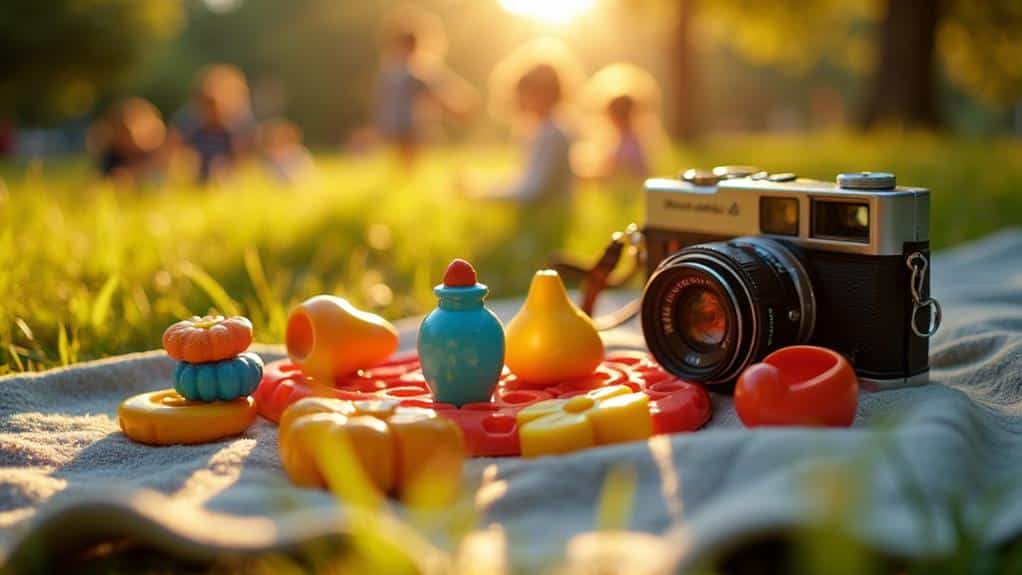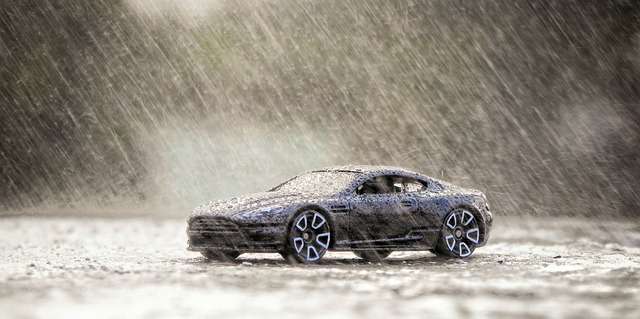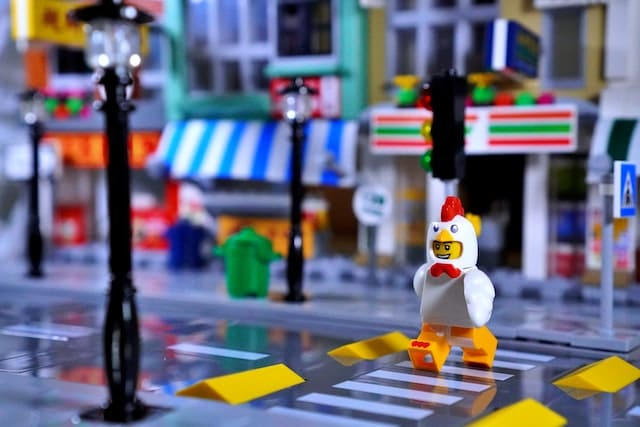When you're capturing magical moments with outdoor toy photography, the first step is selecting toys with intricate details that will pop in your images. You'll want to find a location that complements the story you're trying to tell, whether it's a forest for an adventurous scene or a beach for a playful vibe. Utilizing natural light effectively can make a significant difference, especially during the golden hours. But how do you experiment with angles and depth of field to create truly mesmerizing shots? Keep exploring to discover these secrets and elevate your toy photography game.
Key Takeaways
- Utilize early morning or late afternoon light for soft, warm illumination that enhances colors and reduces harsh shadows.
- Choose visually appealing toys with intricate details and varied colors to make photos pop and captivate viewers.
- Experiment with different angles, including low and ground-level shots, to add dynamism and lifelike qualities to the toys.
- Incorporate props that align with the photo's theme and are proportionate to the toys to enhance storytelling.
- Adjust aperture settings to play with depth of field, using a wide aperture for background blur or a narrow aperture for detailed scenes.
Choosing the Right Toys
When it comes to outdoor toy photography, picking the right toys is crucial to capturing enthralling shots. You want to choose toys that are visually appealing and have intricate details. These details will make your photos pop and draw viewers in. Opt for toys with a variety of colors and textures, as they can add depth and interest to your images. Think about the story you want to tell and select toys that fit within that narrative. Including popular figurines like Funko Vinyl Luffy can also attract a wider audience.
Size matters too. Smaller toys can be easier to manage and position, but larger toys often make a bolder statement. Don't forget to ponder the durability of your toys. Outdoor environments can be rough, so you'll need toys that can withstand a bit of wear and tear.
Articulation is another key factor. Toys with movable joints allow you to create dynamic poses, enhancing the storytelling aspect of your photos. Look for action figures, dolls, or models that offer a wide range of motion. Finally, always carry a small selection of props. Items like miniature furniture, vehicles, or accessories can add context and richness to your scenes, making your outdoor toy photography truly magical.
Finding the Perfect Location
Finding the perfect location for your outdoor toy photography can elevate your shots from good to extraordinary. Start by considering the story you want to tell with your toys. If you're photographing a toy car, a scenic road or a rugged off-road trail can add authenticity. For action figures, a forest or rocky terrain can create a sense of adventure.
Next, think about the scale of your toys. A location with natural elements that match the size of your toys will make your photos more realistic. A garden with small plants or a park with a variety of textures can work wonders. Using different lighting conditions can also enhance the atmosphere and mood of your scene, making your story even more compelling.
Pay attention to the background. A cluttered or busy background can distract from your subject. Choose a location with a simple backdrop that complements your toy. Sometimes, less is more.
Don't forget to explore your surroundings. Look for unique angles and unexpected spots. A small puddle can become a vast ocean in your photo, and a patch of moss can transform into a dense forest
Utilizing Natural Light
Natural light can be your best friend in outdoor toy photography, bringing life and depth to your images. The key is to use it wisely. Early morning and late afternoon, known as the golden hours, provide soft, warm light that enhances colors and reduces harsh shadows. Aim to shoot during these times for the best results. If you're shooting midday, don't worry. You can still avoid harsh shadows by finding shaded areas or using a reflector to fill in shadows. Overcast days are also fantastic because the clouds act as a natural diffuser, giving you soft, even lighting without harsh contrasts.
Positioning is vital. Place the light source behind you to illuminate your toy evenly, or experiment with backlighting for a more dramatic effect. Backlighting can create beautiful rim light around your toy, making it stand out against the background. Using tools like a portable LED light panel can also help control lighting conditions, especially during times when natural light isn't ideal.
Always be mindful of the direction and intensity of the light. Tilt and rotate your toy to catch the light just right, highlighting its details. Remember, natural light changes throughout the day, so keep an eye on it and adapt your shooting strategy accordingly. With practice, you'll master the art of utilizing natural light in your outdoor toy photography
Creating a Storyboard
Capturing the perfect light is just one part of the equation; creating a storyboard is the next step to elevate your outdoor toy photography. A storyboard helps you visualize the sequence of shots and guarantees a cohesive narrative. Start by brainstorming a simple plot for your toys. Are they on a grand adventure, or perhaps in a playful battle? Define the beginning, middle, and end of your story. Additionally, experiment with different angles and perspectives to bring your storyboard to life.
Once you have a plot, sketch out each scene. You don't need to be an artist; simple stick figures and notes will do. This step helps you plan the essential shots and identify any special props or settings you might need. Think about how each scene connects to the next and the emotions you want to convey. Evaluate lighting and direction to guarantee you get the most out of each scene.
Consider the setting for each shot. Will your toys be exploring a forest, climbing a rocky hill, or crossing a stream? Choose locations that best fit your story and create a sense of scale and immersion. Remember, the environment plays a vital role in storytelling.
Experimenting With Angles
Experiment with different angles to bring your toy photography to life. Get creative with perspectives by shooting from above or below, and don't hesitate to utilize ground level for a more immersive view. Try low angles to add grandeur and size to the toy, making your shots more dynamic and engaging. Additionally, consider how natural light can affect your angles and overall composition. These unique angles can make your shots more dynamic and engaging
Play With Perspectives
Exploring different perspectives can transform your outdoor toy photography from mundane to magical. By experimenting with angles, you'll discover new ways to make your toy subjects come to life. Start by getting creative with your camera positioning. Instead of always shooting at eye level, try tilting your camera upwards or downwards to see how the change affects the scene. A low angle can make a toy look larger and more imposing, while a high angle might give you a whimsical, bird's-eye view.
Next, consider the focal length of your lens. A wide-angle lens can exaggerate the proportions of your toys, making them appear more dynamic and engaging. On the other hand, a telephoto lens will compress the background and bring far-off elements closer, adding depth to your composition. Don't be afraid to get up close and personal with macro shots either. Capturing tiny details can create a sense of wonder and intricacy.
Lastly, think about the story you want to tell. Changing your perspective can alter the narrative of your photo. By playing with different angles, you'll add layers of meaning and visual interest, turning simple toy snapshots into mesmerizing works of art.
Utilize Ground Level
When you get down to ground level for your shots, you'll uncover a whole new world of possibilities for your outdoor toy photography. This perspective gives viewers the impression they're part of the miniature world you're capturing. By positioning your camera close to the ground, you can create dramatic angles that highlight your toy's details and make them appear more lifelike and engaging.
Start by placing your camera at the same level as your subject. This angle not only brings a sense of realism but also emphasizes the environment around the toy. You'll find that textures like grass, dirt, and leaves add depth and context to your photos. Don't be afraid to get your hands dirty; sometimes, the best shots come from lying on the ground.
Experiment with different angles by tilting your camera slightly upward or downward. A low angle can make your subject appear larger than life, giving it a heroic quality. Conversely, a slight downward angle can make the scene feel more intimate and grounded. Always take multiple shots from various angles to see what works best. Remember, capturing the magic often requires looking at the world from a different point of view.
Incorporating Props
Props can bring your outdoor toy photography to life by adding context and enhancing the story you're telling. Imagine a toy soldier positioned behind a miniature sandbag barricade or a doll enjoying a picnic with tiny plates and food items. These elements make your scenes more relatable and visually compelling.
To effectively incorporate props, follow these tips:
- Match the Theme: Choose props that align with the theme of your photo. If you're shooting a space adventure, small rocks and aluminum foil can mimic asteroids or a lunar surface. For a nature scene, use leaves, twigs, or even small puddles to create a realistic environment.
- Scale Matters: Guarantee your props are proportionate to the toys. Oversized or undersized items can disrupt the illusion you're trying to create. Small action figures work well with model cars or tiny furniture, while larger dolls might need more substantial items to keep the scene balanced.
- Natural Integration: Seamlessly blend your props into the environment. If you're photographing a toy car on the road, scatter some pebbles or leaves around to make the scene look natural. Don't let the props overshadow your main subject; they should complement, not compete.
Playing With Depth of Field
When playing with depth of field in your outdoor toy photography, adjusting your aperture settings can make a big difference. By widening the aperture, you can blur the background and focus attention on your subject, creating a more dramatic effect. Experiment with different settings to see how the focus shifts and enhances your shots.
Adjusting Aperture Settings
A crucial aspect of outdoor toy photography is adjusting your aperture settings to manipulate depth of field. By controlling the aperture, you can either blur the background to make your toy stand out or keep everything in focus for a more detailed scene. It's all about creating the right mood and directing the viewer's attention.
To master aperture settings, follow these steps:
- Choose a Wide Aperture (f/1.8 – f/4): A wide aperture will give you a shallow depth of field, blurring the background and making your toy the focal point. This is especially useful when you want to isolate your subject from distracting elements.
- Select a Narrow Aperture (f/8 – f/16): A narrow aperture increases the depth of field, keeping more of the scene in focus. This is ideal for shots where you want to capture detailed landscapes or multiple toys in a natural setting.
- Experiment with Mid-Range Apertures (f/5.6 – f/7.1): These settings offer a balance between background blur and detail, perfect for when you're unsure which effect will best enhance your photo.
Adjusting your aperture settings strategically can make a significant difference in your outdoor toy photography.
Focusing on Subjects
To truly highlight your toy subjects in outdoor photography, mastering depth of field is essential. The depth of field refers to the range of distance within a photo that appears acceptably sharp. By manipulating this, you can make your toy the star of your shot while blurring out any distracting backgrounds. Start by using a wide aperture (low f-stop number) to create a shallow depth of field, ensuring your toy stands out crisply against a soft, dreamy backdrop.
Position your toy at a reasonable distance from the background. This enhances the blur effect, rendering the surroundings less noticeable and your subject more prominent. Use the focus point on your camera to lock onto specific features of the toy, like the eyes or the most defining parts. This technique draws viewers' eyes directly to the toy, emphasizing its details and personality.
Don't be afraid to experiment. Try varying the aperture settings and distances to see how different depths of field affect your shots. Practice will help you understand how to control and use depth of field effectively. Remember, capturing those magical moments often lies in the fine details, and mastering depth of field can substantially elevate your toy photography.
Capturing Action Shots
Although capturing still images of toys can be rewarding, nothing beats the thrill of freezing a dynamic moment in time. Action shots add life to your toy photography, making each image more engaging. To master this, you need to focus on timing, lighting, and camera settings.
- Timing is Everything: Anticipate the peak of the action. Whether it's a toy car mid-jump or a superhero in flight, press the shutter button at the exact moment of peak action. Practice makes perfect, so don't hesitate to take multiple shots.
- Optimize Your Lighting: Natural light works wonders for action shots. Early morning or late afternoon light provides the best conditions. Avoid harsh midday sun as it can create unwanted shadows and overexposure. Position your toys so the light highlights their features and motion.
- Adjust Your Camera Settings: Use a fast shutter speed to capture crisp action. A setting of 1/500th of a second or faster is ideal. Switch to burst mode to take a series of shots in quick succession, increasing your chances of nailing the perfect moment.
Editing for Impact
Enhancing your outdoor toy photography doesn't end with the click of a shutter; editing plays a crucial role in bringing your images to life. Start by using basic editing tools to adjust brightness and contrast. This can make your toys pop against the background, enhancing their features and details.
Next, focus on color correction. Adjusting the saturation and hue can transform a dull image into a vibrant, eye-catching photo. Use selective color adjustments to highlight specific elements, such as the toy's vibrant colors or the lush greenery around it.
Cropping is another essential tool. It allows you to remove distractions and emphasize your subject. A tighter crop can draw attention to the toy and create a more engaging composition.
Don't forget about sharpening your images. This enhances the fine details and textures, making your toys look more realistic and appealing.
Experimenting With Perspectives
Changing up your angles can make a world of difference in outdoor toy photography. By experimenting with different perspectives, you can transform an ordinary shot into something extraordinary. Don't just settle for eye-level shots; get creative and explore new ways to capture your toys.
- Low Angle: Shooting from a low angle can make your toys appear larger than life. It gives a sense of grandeur and can make small objects look imposing. This perspective is particularly effective with action figures or vehicles, creating a dynamic and dramatic effect.
- High Angle: Conversely, a high-angle shot can make your toys look vulnerable and small, adding a sense of scale to your images. This perspective is great for creating a bird's-eye view, which can add depth and context to your scene.
- Macro Shots: Get up close and personal with macro shots. This perspective can reveal intricate details that are often missed from afar. It works wonders for showcasing the craftsmanship of your toys and can bring out textures and features that add richness to your photos.
At a Glance
By mastering these tips, you'll transform your outdoor toy photography into magical moments that captivate and inspire. Don't be afraid to experiment with different toys, locations, and angles. Play with light, depth of field, and action shots to create dynamic and engaging images. Finally, enhance your photos through thoughtful editing to bring out the best in your subjects. With practice and creativity, your toy photography will tell enchanting stories that resonate with your audience. Consider incorporating storytelling composition techniques, such as leading lines and framing, to add depth and interest to your images. Additionally, don’t underestimate the power of capturing candid moments and emotions in your outdoor toy photography. By infusing your pictures with a sense of wonder and imagination, you’ll be able to transport your audience to a world of magic and play. Experiment with different styles and techniques to find your unique voice in the world of toy photography.





